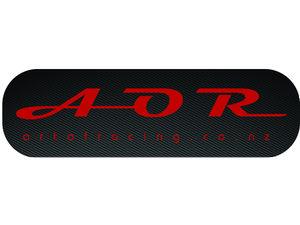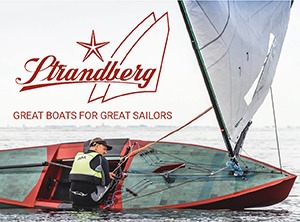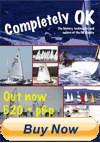You are here: okdia.org > technical > technical manual > off wind
Technical Manual
Off Wind
by David Rose
This article is designed to improve your down wind speed., however it does not set out to describe in detail how to sail the boat in terms of boat handling or sail control but rather an attempt to point you in the right direction.
The first step is to discover what is off wind speed i.e. how much faster is x than yourself ? This can only be done by competing against known exponents of the art. Then by observing their technique and rig control in a look and learn framework, it is possible to build up an understanding of why x's boat is faster. It is not however a blind copy that is required but rather an understanding of the concepts behind their extra speed. This can then be used to control your own rig to maximum effect.
To follow is a brief description of my observations, for you to build on or to disprove.
In general terms four things govern speed:
- Helming technique
- Rig
- Foils
- Hull
This is also the order of importance once items 3 and 4 are of reasonable standard. So a quick summary of points 3 and 4 is in order:
Hull: this must be smooth, stiff, no panel flexing and be rigid as a whole structure, where the transom cannot twist in relation to the mast. Minimum weight and low weight in the ends helps, but this is of little real importance.
Foils should also be smooth with reasonable profiles. The rudder must have no play in any of the joints, as this reduces control and is emphasised by the higher speeds of off wind sailing. Centreboard considerations, as the board is raised the bottom of the board progressively becomes the trailing edge. Therefore, to reduce turbulence, this must emulate the profile of the board when full down. In reality this means faring down the last few inches of the board rather than having an abrupt finish. Stiffness, well, stiff is fast, the further away from the wind you sail, the more reduced is the importance of the automatic reaction of the rig and foils. Therefore, on a reach a stiff board can extract more power, but this of course only works if the board fits the case. However, beware. Many of the above considerations improve off wind speed but can have the opposite effect on windward work.
The above two considerations are determined before racing begins, unlike the rig which is almost infinitely variable whilst on the water. One major setting that is fixed before going afloat is that of mast rake. This however, is mainly determined by boat balance on the windward leg and so is fixed for the off wind leg and has been dealt with on previous occasions. The final consideration to be dealt with in this article is rig control, and this is by far the largest subject. I will therefore split into the three main wind forces.
Light wind (not drifter)
In these conditions the sail needs to present little resistance to the passage of air over it. Therefore a flat sail with an open leech is required. This is best achieved on a bendy rig as a good sail shape can be induced with little leech tension, preventing the sail from stalling.
Mid range
As the wind increases more power is the aim, therefore more camber in the sail and greater leech tension is required.
Leech tension tell tale on second batten just streaming.
Sail camber = tell tale 18" from the leech, just above bottom batten, of which the leeward tale should be just streaming.
This requires a comparatively stiff mast, powerful kicker (18 to 1) and adjustable outhaul (4 to 1) with a matching lens footed main sail.
Heavy airs
The above can be applied to heavy airs until the helm becomes overpowered, when a reversion to light air settings will help to keep the boat under control. Beware too soft a leech on a run though, as this can cause some lively rolling and an inevitable swim. As the wind increases further a mast that remains in control (stiff lower section) and boat handling ability will dictate the boat's speed.
In all conditions less sail camber is required in the sail on a dead run and here is where the sail acts at its most inefficient, therefore technique is the main component in superior speed.
It can be seen that a different sail rig combination is required for light and heavy airs compared to the middle range. As most people do not own a combination of rigs, the aim is to model the rig that suits your weight to the shape that is fast in those conditions. The next step is to get out there, practice boat handling and that all important technique.
So, a quick recap of the basics: a sound hull, foils with fair profiles and a rig suited to the helm's weight. Another important but often forgotten detail is control lines that work under all loading conditions. Given that this is not too difficult to achieve and that the OK is a one design class, certain people seem to have an ability to make them go damn fast. So how? One clue is that the speed difference is most pronounced in marginal conditions. Basically it is their ability to play the waves and gusts on the offwind legs which is the equivalent of spotting wind shifts on the beat.
What follows is a very brief attempt to convey the major factors that affect down wind speed. This is however like trying to teach someone to ride a bike on paper, rather than holding the bike for them to sit on. Nevertheless, a few points can be help beforehand, e.g. which is the front and how the bell works.' The comparison with a bike is on purpose, for the more I have seen people with the ability to sail fast off wind, the more it confirms my belief that it is knack, learnt rather like learning to ride a bike, and some can excel, but all can learn.
- Sail Trim
- Waves
- Steering
- Gusts
1. Sail Trim
Never oversheet the sail, as this is death to boat speed. The sail will require constant trimming over the whole leg of the course including the run. Correct sail trim is when the luff is just about to lift, so let the sail out until it lifts then sheet back, this is then repeated again and again and again and again and again.
2. Waves
If they exist, will play a very major part on the off wind leg and they don't have to be very large to have considerable effect. Most people at some time or other have seen a surfer tackle a wave. This is the technique required for your OK if somewhat less flamboyant. It consists of bearing the boat down the face of the wave then zigzagging the boat to maintain position on the wave. This can be developed into a rhythm of catching, playing eventually losing, then preparing for the next. You should endeavour in these manoeuvres to use only boat balance to steer the boat.
3. Steering
The rudder is bad news as every rudder is used it is like putting the hand brake on. boat must be steered as much as possible by the use of body weight and sail trim.
4. Gusts
They must be incorporated into the above three to achieve maximum performance, e.g. as the gust hits you must trim the sail but at the same time use body weight to bear the boat off down a wave. As you might guess, this is easier to say than do. Good co-ordination in the boat, an eye up to weather to spot the gust moving in (dark water, clouds, etc. are often good warning of gusts), and a lot of practice.
Most of the above theory works in all weather conditions. It is very surprising on how small a wave an OK will plane or how much a slight gust can increase boat speed when dealt with properly. It requires constant concentration and awareness, as a gust moves in, the aware sailor moves to meet it and hence gain vital seconds in the stronger wind.
As a final thought, don't be fooled by the guy who speeds along almost effortlessly. He will certainly be working, and have worked hard to achieve this happy state.
N.B. Practice makes perfect and perfect wins races!










